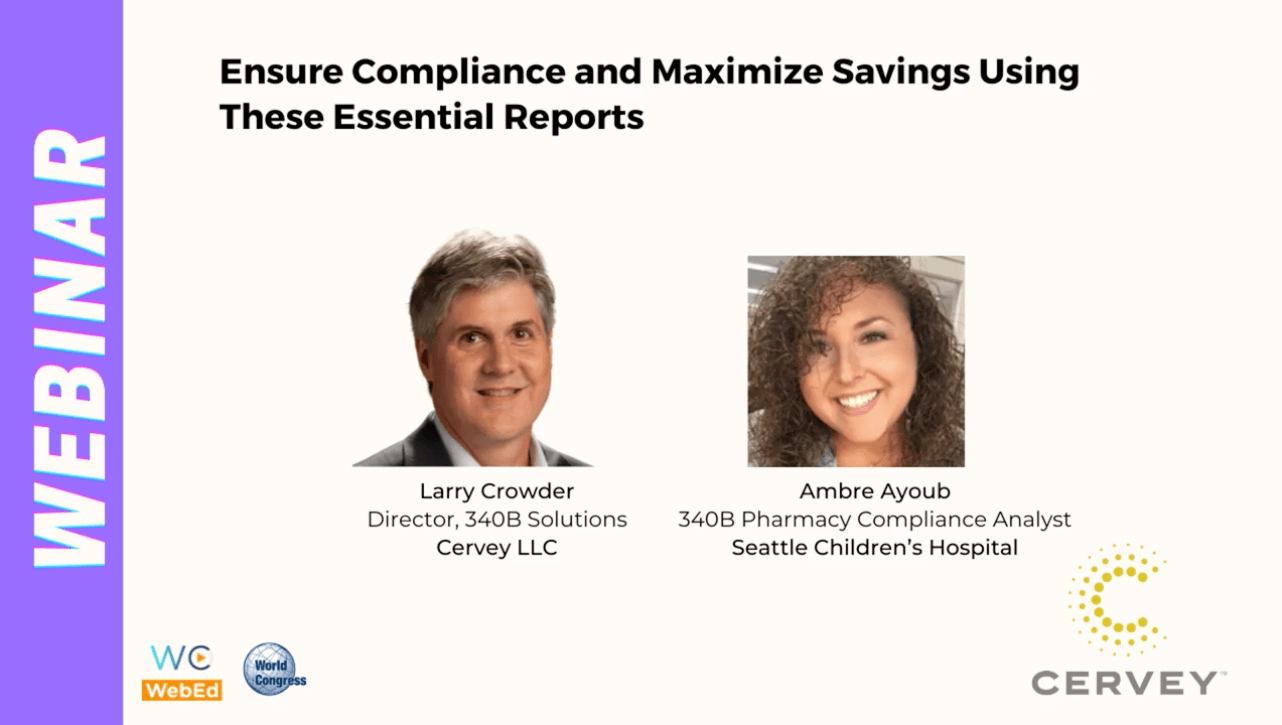
Modern Healthcare Technology Blog
.jpg)
340B Webinar Series - 340B Compliance and Savings: Part 7
Part 7 of the 340B Webinar Series – 340B Advanced Reporting, Larry Crowder, VP of 340B Solutions at Cervey talks with Ambre Ayoub, 340B pharmacy compliance analyst with Seattle Children's Hospital to review the weekly, monthly, quarterly and annual self-audit reports used to ensure compliance and maximize savings for their 340B Program.
Missed parts 1 through 6? You can find more info below:
- Part 1: NDC or Code Mismatch Report
- Part 2: WAC Impact Report (DSH/PED)
- Part 3: Missed 340B Savings Report
- Part 4: 340B Variance Report
- Part 5: Billing Unit Verification Report

340B Webinar Series -340B Advanced Reporting: Part 7
Before we jump in, there are a few key items I want to mention. I recently reviewed the Top Five Reports to Ensure 340B Compliance and Maximize Savings. While these five reports are essential, it’s always beneficial to hear what other Covered Entities are doing to ensure compliance. Ambre Ayoub, 340B Pharmacy Compliance Analyst at Seattle Children’s Hospital, has been gracious enough to share with us what they do on a weekly, monthly, quarterly and annual basis. Keep in mind, Seattle Children’s is advanced in their data analytics. If you’re not running all these reports, you’re not alone, but you can use Ambre’s insight as a building block or goal to work towards, and hopefully, gleam new ideas to apply to your own 340B program.
With that, Ambre, let’s go ahead and dive in. Can you kick us off with your day-to-day priorities?
DAILY REPORTS
Ambre Ayoub:
Daily, I have time set aside for my morning tasks. One of the first items on my list is to check the split billing system – I make sure our daily file uploaded correctly, and then check the line counts. It’s so important because, maybe most days you get a thousand dispenses and today you get five. You want to make sure the numbers are accurate to avoid issues between your data feed and your extract.
Secondly, I check the prescriber and location rejections and verify that the items are being rejected appropriately. I also look at the exceptions (unknown item numbers). A lot of our exceptions are inner and outer NDC. That’s why it’s important to pay attention to those along with any linking issues.
Larry Crowder:
For those of you unfamiliar with the term “exceptions,” because that might not be a term that every TPA uses, an exception would be an item number that comes across that isn’t recognized by the software. That’s why it’s important to link to the appropriate NDC. For example, if you're using CDMs (hospital charge code numbers) or if you send across a fake NDC using a 999 number it will not match an NDC in the item catalog of your wholesaler and that would be considered an exception.
Ambre Ayoub:
Absolutely. It requires manual review.
MONTHLY REPORTS
Larry Crowder:
Thanks, Ambre. That’s great insight into your day-to-day. Would you mind sharing what you do on a monthly cadence?
Ambre Ayoub:
Sure. Monthly, we use the WAC Impact Report Larry discussed to check our negative values and ensure that our package sizes and multipliers are accurate. Then, we do a direct vendor audit.
A Direct Vendor Audit is where we review all our direct vendors that we input into our optimizer system. We compare what we manually enter for purchase orders against the vendor purchasing reports, just to ensure that the quantities were accurate, and that the accounts that were used were appropriate. That also gives us an opportunity to look at credits. I know sometimes we might miss a credit report from our purchasing team.
Looking at those vendor purchases, we can make sure to add back any accruals that were credited on those reports. I do a data sample of invoices from our third-party processing system, and then compare that to our wholesaler report on a monthly basis to ensure that the quantity deducted was accurate based on the invoice.
Then, we conduct our Monthly Diversion Audits. We perform two types of diversion audits – the first is basically a Tracer Audit. We go through the entire process of what HRSA would expect when they come on-site to do an audit – meaning we download our sample data from our third-party processing system and compare it to our source of truth. For us, that’s Epic.
We compare and show – taking screenshots of where the information located in Epic that's translating from our data extract into the Cervey Split-Bill software. I also want to point out that it’s important to pay attention to your data sample. Make sure that your data sample makes sense for you based on how many encounters you get on a daily or weekly basis.
We also perform a Duplicate Discount Audit. We download that to ensure encounters are processing accurately and not allowing for a duplicate discount for Medicaid or Medicare.
Next, we do a “Hello and Goodbye” Report. This is a report that our credentialing team sends us with a list of our providers that may have an end date that's mid-month. We want to ensure that if a provider, for whatever reason, leaves an organization, he or she does not have encounters that are approving on 340B.
Then, we do a Location Review Audit. We don't do a data set for that, but instead, download our encounters for 340B for the entire month to compare to our location crosswalk. We want to make sure there are no discrepancies.
Then we do an Accumulation Vs. Purchase History Audit. This is the same as our Location Audit, where I download the encounters for the month and compare the NDCs to our wholesaler purchases. We go back two years because we might have a slow mover depending on the location. This also ensures that it is a product that we actually purchased. You can't accumulate on a drug if it hasn’t been purchased. That would be a huge ding in an audit.
The second diversion audit that I was talking about in comparison to the Tracer Diversion Audit is the 4P Audit. This is where we ensure that the patient is eligible as outpatient, and confirm the provider is also eligible. We do a VLookUp based on the end dates for the provider in that audit, the location, and the product eligibility.
We identify any bundled item we aren't accumulating on. I look at the drugs and NDCs to ensure that nothing is accumulating that shouldn't be based on our policies, procedures and what our entity does for eligible items.
And then as an overall monthly audit, we conduct our GPO Prohibition Audit. This might not apply to everyone on the call, but for our entity, we ensure we don't have any Nova plus (Novation private label items) NDCs that are accumulating because that is a stipulation for GPO prohibition entities. Then, we verify 340B eligibility for those drugs that we use regularly and are expensive but weren’t previously eligible.
QUARTERLY REPORTS
Larry Crowder:
That’s good insight. What about on a quarterly basis?
Ambre Ayoub:
Quarterly, we do the Purchasing Variance Report you mentioned previously. And then, we conduct a Case Rate Audit to make sure that case rate claims are not being billed to insurance but are instead billed to a separate internal plan. To reiterate, that's just for my entity. It might be different for others. This is specific to our mixed use and retail sites.
We also do our NDC, EX and Item Code Crosswalk. We use those in coordination with our billing unit report to ensure everything is listed and linked. Any notes for inner and outer NDCs apply for our crosswalk. And then we check direct vendor prices. On a quarterly basis, we’re making sure that the prices are updated accurately in our third-party processor optimizer system.
If the prices are accurate, it ensures our savings are accurate when we report to our 340B committee. I also do a quarterly Ignored NDC Exception Review. Again, this is something that may be unique to our entity. But we encountered a few bugs after switching to Epic last year and were accumulating on NDCs that we might not have purchased. To troubleshoot, I ignored the exceptions in the system, and then went back to verify if it's something that we have started to accumulate so we're not missing opportunities. If it's something that I need to “unignore” in our system, we can actually start accumulating on that item.
Then, I do a Last Purchase Review Note Audit. Here, I’m just double checking that the last purchase date of an item matches whether we’re accumulating on that item. And then, we do a quarterly OPAIS Price Review Audit. We alternate between using a sample of the 20 most utilized and the 20 highest priced drugs to ensure that our contracted rate with our wholesaler is not above the ceiling price in OPAIS.
Next is our Drug Exclusion Audit, where we first confirm no 340B excluded drugs are accumulating, and then check our overall program with a GPO Contract Prohibition Audit. Here, we’re ensuring any GPO contracts have been added to our WAC or non-340B account aren’t being used to purchase outpatient drugs. And then, of course, we audit our Medicaid exclusion file.
We ensure that our exclusion file is loaded in OPAIS accurately with the correct NPIs, names and Medicaid numbers. Then we do a quarterly HRSA OPAIS Database Audit. We have a spreadsheet for everything that the database has, and check with our authorizing official that this information is accurate. We do an overall system review based on what HRSA would see in OPAIS to make sure that it's all correct.
ANNUAL REPORTS
Larry Crowder:
Annually, what kind of reports do you run?
Ambre Ayoub:
For us right now, we use our gases and our barium status for bundling. We don't accumulate on those for 340B. But on an annual basis, we check to see if there has been a change with Epic that would allow us to start accumulating on those items.
Our contract agreements we also review on an annual basis. We make sure that our contracting agreements are up-to-date, and that the agreement we have that allows us to participate in the program. Then we verify Medicaid. We connect with our Medicaid contacts to make sure there hasn’t been any changes from state to state that would affect us accurately filling in the system.
We, of course, also do our HRSA re-certification. We meet annually with our committee team to discuss any updates or changes. For our entity, we prioritize the 340B Health seminars for updated changes so we’re on top of everything for recertification. Then, we do our annual Location Crosswalk Review to check all locations are reflected on our crosswalk, and that the information is accurate. We compare that review to the Medicaid Cost Report to make sure that it's there and that it's a reimbursable location so that we can accumulate.
Then we do our 340B Universe Mapping, validating that our documents are up-to-date, making any necessary corrections to what we have when we show HRSA.
Annually, we do a Shine Drill – an opportunity for us to have all-hands-on-deck for a mock audit. We also do a P/P review on an annual basis because policies and procedures are constantly changing. We want to make sure that, at least yearly, we’re doing a deep dive into all our policies, procedures and our job aids to ensure everything is accurate and up to date, so that if and when HRSA is onsite, we can just say, "Oh, here you go. Here is everything, relevant and accurate."
Then, we do an annual review of our 340B Learning Center. It’s important to us that the entire organization understands 340B and the role that everyone plays in it, because it's not just pharmacy. The whole organization contributes to the program. This means we do different learning center tools for providers, for committee members and for the pharmacies themselves to ensure everyone understands the importance and their role.
BIENNIAL REPORTS
Ambre Ayoub:
Every other year we conduct an Independent External Audit with Visante, where they come onsite and audit our program.
Conclusion
Larry Crowder:
It’s clear the reporting process at Seattle Children's is incredibly in-depth and thorough. I don't want anybody to be discouraged by how many things they do, but instead, see all the possibilities that are out there to ensure compliance and maximize savings. And if you are trying to get someone hired as a 340B manager, and they're wondering, “Is this really an FTE?” Well, there's your answer. That’s how much can be done, all the way down to the training of other employees, to make sure everybody understands 340B.
What Ambre shared, while advanced, could be a good goal to work towards. Start with the five reports. That’s a great foundation to build on. Integrating those five reports with your 340B program will help you to begin naturally identifying other areas your entity needs to review.
Always have a plan of action for any findings that you come across. Keep your material breach number in your head. Get in a peer group and share ideas. "Well, this is what we use…This is what we use as a material breach number." And you’ll be on your way to mastering compliance and maximum savings.
Follow us to stay tuned for upcoming webinar announcements:
Contact Cervey for a demo of our 340B suite of web-based products that help 340B-eligible healthcare providers with three of their most pressing 340B needs: maximizing savings, ensuring compliance, and optimizing the performance of their contract pharmacies.
Looking for the rest of the webinar series? Check out parts 1-6 below:
- 340B Webinar Series - 5 Reports to Ensure 340B Compliance and Maximize Savings: Part 1
- 340B Webinar Series - 5 Reports to Ensure 340B Compliance and Maximize Savings: Part 2
- 340B Webinar Series - 5 Reports to Ensure 340B Compliance and Maximize Savings: Part 3
- 340B Webinar Series - 5 Reports to Ensure 340B Compliance and Maximize Savings: Part 4
- 340B Webinar Series - 5 Reports to Ensure 340B Compliance and Maximize Savings: Part 5
- 340B Webinar Series - 5 Reports to Ensure 340B Compliance and Maximize Savings: Part 6


